教案:Period6Studyskills
Unit 6 Study skills教案2022-2023学年牛津译林版英语七年级上册
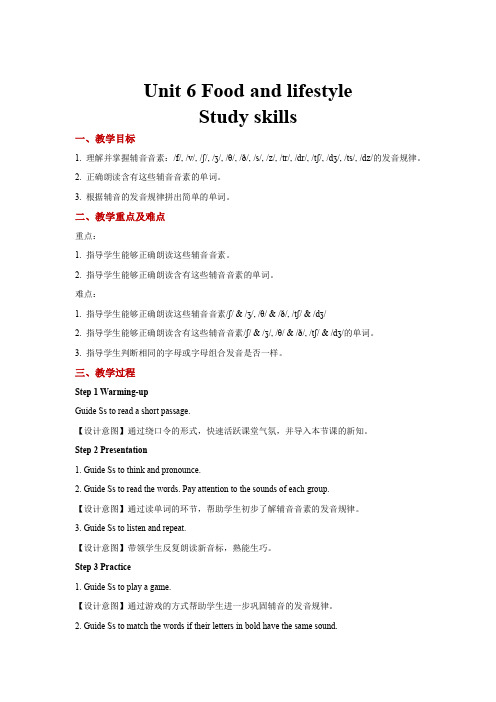
Unit 6 Food and lifestyleStudy skills一、教学目标1. 理解并掌握辅音音素:/f/, /v/, /ʃ/, /ʒ/, /θ/, /ð/, /s/, /z/, /tr/, /dr/, /tʃ/, /dʒ/, /ts/, /dz/的发音规律。
2. 正确朗读含有这些辅音音素的单词。
3. 根据辅音的发音规律拼出简单的单词。
二、教学重点及难点重点:1. 指导学生能够正确朗读这些辅音音素。
2. 指导学生能够正确朗读含有这些辅音音素的单词。
难点:1. 指导学生能够正确朗读这些辅音音素/ʃ/ & /ʒ/, /θ/ & /ð/, /tʃ/ & /dʒ/2. 指导学生能够正确朗读含有这些辅音音素/ʃ/ & /ʒ/, /θ/ & /ð/, /tʃ/ & /dʒ/的单词。
3. 指导学生判断相同的字母或字母组合发音是否一样。
三、教学过程Step 1 Warming-upGuide Ss to read a short passage.【设计意图】通过绕口令的形式,快速活跃课堂气氛,并导入本节课的新知。
Step 2 Presentation1. Guide Ss to think and pronounce.2. Guide Ss to read the words. Pay attention to the sounds of each group.【设计意图】通过读单词的环节,帮助学生初步了解辅音音素的发音规律。
3. Guide Ss to listen and repeat.【设计意图】带领学生反复朗读新音标,熟能生巧。
Step 3 Practice1. Guide Ss to play a game.【设计意图】通过游戏的方式帮助学生进一步巩固辅音的发音规律。
2. Guide Ss to match the words if their letters in bold have the same sound.3. Guide Ss to listen and write S (same) or D (different).4. Guide Ss to practice saying the following sentences.【设计意图】通过简到难的练习,帮助学生及时巩固所学知识。
studyskills初中教案

studyskills初中教案教学目标:1. 帮助学生了解和掌握学习英语的基本技巧和方法。
2. 培养学生自主学习的能力和习惯。
3. 提高学生学习英语的兴趣和积极性。
教学内容:1. 学习计划的制定与执行。
2. 词汇的记忆与积累。
3. 课文的阅读与理解。
4. 听力和口语的训练。
5. 考试技巧的掌握。
教学过程:Step 1: 导入(5分钟)1. 向学生介绍本节课的主题:学习英语的技巧。
2. 引导学生思考:他们在学习英语过程中遇到的问题和困难。
Step 2: 学习计划的制定与执行(10分钟)1. 向学生讲解如何制定学习计划,包括每天的学习时间、学习内容等。
2. 引导学生根据自己的实际情况制定学习计划,并执行。
Step 3: 词汇的记忆与积累(10分钟)1. 向学生介绍几种记忆词汇的方法,如联想记忆、分类记忆等。
2. 让学生练习记忆一些常用的英语词汇。
Step 4: 课文的阅读与理解(10分钟)1. 向学生讲解如何阅读和理解英语课文,如先读题目、找出关键词等。
2. 让学生阅读一篇英语课文,并回答相关问题。
Step 5: 听力和口语的训练(10分钟)1. 向学生讲解如何进行听力和口语的训练,如每天听英语歌曲、跟读课文等。
2. 让学生听一段英语对话,并回答相关问题。
Step 6: 考试技巧的掌握(5分钟)1. 向学生讲解一些考试技巧,如做题的顺序、如何利用排除法等。
2. 让学生做一些英语练习题,并讲解答案。
Step 7: 总结与反思(5分钟)1. 让学生总结本节课所学的英语学习技巧。
2. 引导学生反思自己在学习英语过程中存在的问题和困难,以及如何解决。
教学评价:1. 观察学生在课堂上的参与程度和表现,了解他们对于学习英语技巧的掌握情况。
2. 通过课后作业和练习题的完成情况,了解学生的学习效果。
教学反思:本节课通过讲解和练习,让学生了解和掌握了一些学习英语的基本技巧和方法。
但在教学过程中,需要注意以下几点:1. 针对不同学生的学习情况,给予个性化的指导和建议。
初中英语七年级上册(牛津译林版)Unit6Studyskills教学设计

2.针对阅读教学:
(1)采用预测、扫读、精读等策略,引导学生逐步提高阅读理解能力。
(2)设计具有针对性的阅读练习,帮助学生把握文章主旨和细节。
(3)鼓励学生进行课外阅读,拓宽知识面,提高阅读兴趣。
3.针对口语教学:
三、教学重难点和教学设想
(一)教学重难点
1.重点:本章节的重点在于学生对描述人物和日常生活的词汇、句型的掌握,以及一般现在时和一般过去时的运用。
难点:学生对于一般过去时的构成和运用容易混淆,同时在阅读过程中,对文章主旨和细节的把握存在困难。
2.重点:培养学生运用阅读策略,提高阅读理解能力。
难点:学生在阅读过程中,如何将所学策略灵活运用,提高阅读效率。
5.结束语:Learning English is not only about memorizing words and sentences, but also about observing and describing the world around us. I hope you can use what you have learned today to communicate with others and improve your English skills.
5.预习作业:预习下一节课的内容,提前了解新词汇和句型,为新课的学习做好准备。
作业要求:
1.请同学们认真完成作业,注意书写规范,保持卷面整洁。
2.家长签字确认,加强对学生学习情况的了解和监督。
3.教师将针对作业完成情况进行检查和评价,鼓励同学们在完成作业的过程中积极思考、主动探究。
(1)创造一个轻松、愉快的课堂氛围,让学生克服紧张情绪,大胆开口说英语。
牛津译林版九年级英语上册Unit 6 Study skills 示范课教案

通过本课时的学习,学生能够:
1.梳理英文报纸标题和文章的特点。
2.在英文报纸中快速获取关键信息。
3.有意识通过新闻报纸获取信息,关注正在发生的事件,丰富自己的知识储备。
四、教学重难点
【重点】
1.梳理英文报纸标题和文章的特点。
2.能够在英文报纸中快速获取关键信息。
【难点】
能够在英文报纸中快速获取关键信息。
Unit6TV programmes
Period 6 Study skills
一、教学内容分析
本节课是本单元的学习技巧课。主要内容包括Studyskills板块,了解英文报纸的标题特点及写作风格,学习阅读英文报纸。
二、学情分析
学生通常对英文报纸接触较少,认识不多,不是很了解如何快速从英文报纸中获取想要的信息,对报纸类文章的行文特点缺乏了解。
活动层次
学习理解之获取与梳理
应用实践之分析与判断、概括与整合
效果评价
观察学生完成练习和总结的情况,了解学生是否掌握了报纸新闻标题的特征。
环节设计意图:学习新闻标题,掌握其特点。
环节三:结合新闻内容,了解新闻类文章的写作风格及特点(10 mins)
教师展示一篇报纸上的新闻,通过提问的方式,引导学生了解新闻类文章的写作风格和特点。
教学活动
7.Students readthe article and answer the questions.
8.Students summarizethe specialwritingstyle of newspaper articles.
活动层次
学习理解之获取与梳理
应用实践之分析与判断、概括与整合
作业与拓展
1. Read some newspaperevery day and form a habit.
Unit6 Study skills 优质课教案(江苏省2)
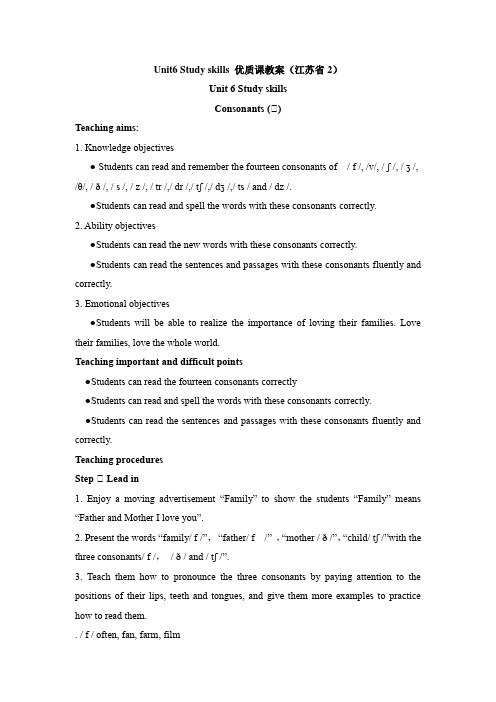
Unit6 Study skills 优质课教案(江苏省2)Unit 6 Study skillsConsonants (Ⅱ)Teaching aims:1. Knowledge objectives● Students can read and remember the fourteen consonants of / f /, /v/, / ʃ /, / ʒ /, /θ/, / ð /, / s /, / z /, / tr /,/ dr /,/ tʃ /,/ dʒ /,/ ts / and / dz /.●Students can read and spell the words with these consonants correctly.2. Ability objectives●Students can read the new words with these consonants correctly.●Students can read the sentences and passages with these consonants fluently and correctly.3. Emotional objectives●Students will be able to realize the importance of loving their families. Love their families, love the whole world.Teaching important and difficult points●Students can read the fourteen consonants correctly●Students can read and spell the words with these consonants correctly.●Students can read the sentences and passages with these consonants fluently and correctly.Teaching proceduresStep Ⅱ Lead in1. Enjoy a moving advertisement “Family” to show the students “Family” means “Father and Mother I love you”.2. Present the words “family/ f /”,“father/ f/” ,“mother / ð /”,“child/ tʃ /”with the three consonants/ f /,/ ð / and / tʃ /”.3. Teach them how to pronounce the three consonants by paying attention to the positions of their lips, teeth and tongues, and give them more examples to practice how to read them.. / f / often, fan, farm, film/ ð / father, mother, those, this/ tʃ / match, children, chicken, chairStep Ⅱ PresentationT: I have a happy family. I love my mother and father, they love me too. Do you want to know more about my family1. Show a picture of a farm and say: This is a picture of mum’s farm, but she is too old to put all the things in the right places. Please listen and help her stick the things on the paper correctly. Listen:2. While sticking, show the following sentences to present the consonants/ ts /, /v/, / ʃ/,/ tr /,/ s /and/θ/.Mum plan ts/ ts / some vegetables/v/ on the farm. Lots of fi sh/ ʃ / are in the river. By the river, there is a big tr ee/ tr /. There are many green leave s/ s / on the tree. How beautiful mum’s farm is! Don’t you th ink/θ/ so3. Teach them how to pronounce these consonants by paying attention to the positions of their lips, teeth and tongues. Divide them into six groups to see which group can put the words with the same sound together quickly and correctly.. / ts / starts, sports, rabbits / v / very, over/ ʃ / fish, short, shoe, sheep / tr /travel, trousers, train, tree/ z / sometimes, zoo, always / θ / thank, thin, bothStep Ⅱ Presentation1. Listen to something about my Dad, and then fill in the blanks.My father is a little fat/ f /. He seldom / s / exercises. He thinks /θ/ it’s nice/ s / to watch television/ ʒ / with friends/ dz /.2. After filling in the blanks, present these consonants/ s /,/ ʒ /and/ dz /.3. Teach them how to pronounce these consonants by paying attention to the positions of their lips, teeth and tongues. Practice how to read them.4. Please find out who is different from other.①②③shorts usually handsscience television readsnurse vegetables coatsnose pleasure spendsStep Ⅱ Presentation1. Do you want to know more about me Showing the sentences while telling.I like g eography/ dʒ / very much. My dr eam/ dr / is to take my family to travel around the world. What present do you think is the best for me2. Show three presents for the students to choose.A. an English bookB. a pair of jeansC. a globe(地球仪)3. Teach them how to pronounce these consonants by paying attention to the positions of their lips, teeth and tongues. Practice how to read the words with / dʒ /,/ dr /.Step Ⅱ Practice1. Mum’s dream is to plant the best vegetables in the world. She heard if she puts the letters with the same sound in the same hole, it will produce a kind of soil which can make her vegetables grow better and faster. Can you help her Give the students the following words : dress, wish, change, there, together, thing, show, drink, watch, health, driver, shirt, chair, that, and thin/ dr /dress, drink, driver / ʃ / wish, show, shirt/ tʃ / change, watch, chair, / ð / there, together, that/ θ / thing, health, thin2. Dad is old, he can’t hear what mum wants clearly, please listen and help him choose.( ) . fan B. fat C. fun( ) . fridge B. juice C. jump( ) . shirt B. sheep C. fish( ) . chair B. watch C. chicken( ) . coats B. cats C. rabbits( ) . tree B. train C. trousersListening materials①It’s too hot. Could you bring me the new fan, Mr Gu②Oh, I’m a little thirsty, would you please pass me the juice③Supper is ready. Taste the fish. How delicious it is! Don’t you think so④There’s something wrong with the clock. Can you show me your watch⑤I want to keep some pets on the farm. Would you like to buy some rabbits for me⑥Your birthday is coming! I bought a pair of trousers for you. Would you like to try them on3. Reading for fun.Ask students to read the followings in groups as fast as they can.①Sh e s ell s s eashell s by the s ea s hore. The sh ell s sh e s ell s are s urely s ea sh ell s. S o if sh e s ell s sh ell s on the s ea sh ore. I’m s ure sh e s ell s s ea sh ore sh ell s.②MothersF rien ds and lover s may come and go,but mo th er s are f orever as you know!Mo th er s love you good or bad,My mo th er s th e very best friends I've ever had.Th ere is no th ing more precious on ear th,o th er th an th e day when sh e gave bir th....③The coun tr y ch ildMy home is a house near the woo ds,I would live in a s tr eet if I could!The villa g e is so quiet, oh, dear!I do wi sh th at someone lived near!Plea s e let me live in a town,Too s ee all the tr a ff ic going down!Roa ds and str ee ts are all bright,Wi th wonder f ul color s at night!Step Ⅱ ConclusionLove father, love mother, love our family!Our world is a big family; we should love her, too.If so, our world will be better and better.Step Ⅱ Homework1. Read the words with the 14 consonants after class.2. Find more sentences or tongue twisters to read for fun.。
牛津译林版九年级英语上册Unit 2 Study skills 示范课教案
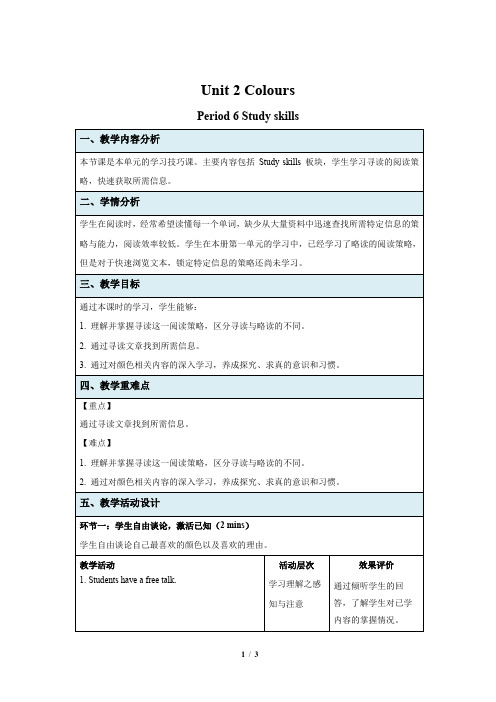
学生阅读语篇并回答问题,复习略读策略,再通过回答问题和判断正误的活动学习寻读策略,并归纳总结寻读这一阅读策略的特征,同时对略读和寻读进行比较。
教学活动
2.Students read and answer some questions.
三、教学目标
通过本课时的学习,学生能够:
1.理解并掌握寻读这一阅读策略,区分寻读与略读的不同。
2.通过寻读文章找到所需信息。
3.通过对颜色相关内容的深入学习,养成探究、求真的意识和习惯。
四、教学重难点
【重点】
通过寻读文章找到所需信息。
【难点】
1.理解并掌握寻读这一阅读策略,区分寻读与略读的不同。
2.通过对颜色相关内容的深入学习,养成探究、求真的意识和习惯。
环节设计意图:检测学生是否能够使用寻读策略快速寻找信息,同时通过对历史上男孩与女孩对蓝色与粉色的选择的变化,引导学生形成查阅资料了解信息的意识,发展批判性思维能力,培养求真的习惯和意识。
作业与拓展
1. Try to think of more examples about when scanning is usually used in your daily life.
Unit 2Colours
Period 6 Study skills
一、教学内容分析
本节课是本单元的学习技巧课。主要内容包括Studyskills板块,学生学习寻读的阅读策略,快速获取所需信息。
二、学情分析
学生在阅读时,经常希望读懂每一个单词,缺少从大量资料中迅速查找所需特定信息的策略与能力,阅读效率较低。学生在本册第一单元的学习中,已经学习了略读的阅读策略,但是对于快速浏览文本,锁定特定信息的策略还尚未学习。
Unit 6 Study skills 教案 2022-2023学年牛津译林版八年级英语上册

Unit 6 BirdwatchingStudy skills一、教学目标1. 掌握本课重点词汇:speaker, tour2. 能够用-er, -or, 和-ist构成表达身份和职业的名词。
3. 能够谈论有关自己最喜欢的自然保护区,并使用名词后缀介绍人们为保护野生动物所做的努力。
二、教学重点及难道重点:1. 能够用-er, -or, 和-ist构成表达身份和职业的名词。
2. 能够谈论有关自己最喜欢的自然保护区,并使用名词后缀介绍人们为保护野生动物所做的努力。
难点:熟练掌握-er, -or和-ist构成的表达身份和职业的名词。
三、教学过程Step 1 Warming-upGet Ss to look at the pictures and talk about the people.【设计意图】通过看图说出图片人物身份的相关信息,引导学生在聚焦意义的同时,感知语法的语用功能。
Step 2 PresentationGet Ss to learn the suffixes -er, -or and -ist. Then get some tips about them.【设计意图】通过展示语法的规则和例词,帮助学生聚焦语法的构成和意义。
为学生提供构成的小策略,帮助学生加强记忆。
Step 3 Practice1.Get Ss to change verbs into nouns and then put them into groups.【设计意图】通过规则提示进行分类并进行单词转换,帮助学生深化对名词构词的认识。
2.Get Ss to fill in the blanks.3. Get Ss to complete the sentences with the correct nouns of the words in brackets.【设计意图】通过句子层面和篇章层面分别进行语言操练,在语境中使用并感知语言,符合学生的认知规律,符合学习的本质。
牛津译林版英语7AUnit6Studyskills教学设计

四、教学内容与过程
(一)导入新课
1.教学活动设计:教师通过向学生展示一组图片,图片内容涵盖本单元所学的重点词汇和短语,引导学生进行看图猜词的游戏,激发学生的学习兴趣。
2.教师提问:在游戏结束后,教师针对图片中的词汇提问,如:“How do you learn English words effectively?”、“Can you tell me some study skills you know?”,让学生自由发表观点,为新课的学习做好铺垫。
(五)总结归纳
1.教学内容:对本节课所学的阅读策略、文章主旨和细节信息的把握方法进行总结。
2.教师引导:教师通过提问,引导学生回顾本节课的学习内容,如:“What have we learned today?”、“How can we apply these study skills to our daily reading?”。
3.设计梯度性的课堂任务,针对不同水平的学生,提供不同难度的任务,使每个学生都能在完成任务的过程中获得成就感。
4.加强课堂互动,注重师生之间的情感沟通,关注学生的心理需求,及时给予鼓励和支持。
5.利用课后作业和课堂反馈,了解学生的学习进度和困难,针对性地进行辅导和指导。
6.开展课外活动,如英语角、学习经验分享会等,为学生提供更多的实践机会,巩固所学知识。
牛津译林版英语7AUnit6Studyskills教学设计
一、教学目标
(一)知识与技能
在本章节中,我们将围绕牛津译林版英语7A Unit 6 Studyskills展开教学。通过本章节的学习,学生应掌握以下知识与技能:
初中英语八年级上册(牛津译林版)Unit6Studyskills教学设计

2.能力层面:学生的听说能力相对较强,但阅读和写作能力有待提高。此外,他们在实际运用所学知识时,可能存在一定的困难。
3.情感态度:学生对英语学习兴趣较高,但部分学生对学习习惯和方法的重要性认识不足,需要引导他们认识到良好的学习习惯对英语学习的重要性。
(2)录制一段关于学习方法的口语视频,分享到班级群,与同学们互相学习、交流。
4.拓展作业:
(1)利用课外时间,了解一位成功人士的学习方法和习惯,并结合自己的实际情况进行借鉴。
(2)查阅资料,了解不同国家学生的学习习惯和方法,撰写一篇关于比较国内外学习差异的英文小短文。
作业要求:
1.书面作业要求字迹工整,语言表达清晰,准确运用所学词汇和句型。
(三)情感态度与价值观
1.认识到良好的学习习惯对学习的重要性,自觉养成良好的学习习惯。
2.树立自信心,相信自己通过努力可以提高学习成绩,激发学习内驱力。
3.学会尊重他人,善于倾听他人的意见,善于与他人合作,共同解决问题。
4.养成积极主动学习的态度,珍惜时间,合理安排学习与生活。
5.培养对英语学习的兴趣,树立长期学习英语的决心。
在教学过程中,教师应关注学生的个体差异,鼓励学生积极参与,充分调动学生的学习积极性,使他们在愉快的氛围中学习,不断提高英语素养。同时,教师还要注重培养学生的思维品质、文化意识和学习能力,为他们的终身学习奠定基础。
二、学情分析
八年级的学生已经具备了一定的英语基础,对英语学习有了一定的了解和认识。在此基础上,他们对本章节的学习有以下特点:
难点:如何引导学生将所学的学习方法应用到实际学习中,提高学习效率;以及如何让学生在实际语境中熟练运用一般现在时和一般过去时。
新译林 Unit 6 Study Skills 教学设计
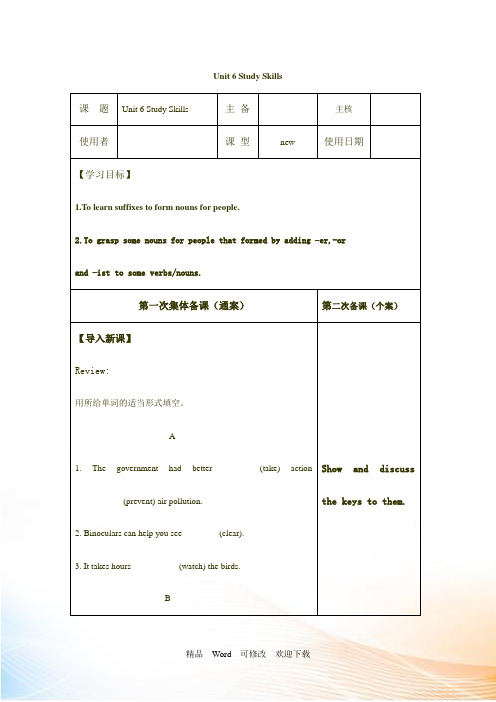
Unit 6 Study Skills课题Unit 6 Study Skills 主备主核使用者课型new 使用日期【学习目标】1.To learn suffixes to form nouns for people.2.To grasp some nouns for people that formed by adding –er,-orand –ist to some verbs/nouns.第一次集体备课(通案)第二次备课(个案)【导入新课】Review:用所给单词的适当形式填空。
A1. The government had better ______ (take) action _________(prevent) air pollution.2. Binoculars can help you see ________(clear).3. It takes hours __________ (watch) the birds.B Show and discuss the keys to them.1. Many ________(visit) come to Yancheng Nature Reserve to go birdwatching every year.2. There are ________(speak) in each corner of the hall.3. Yi Jianlian is my favourite basketball ________(play).4. Einstein was one of the greatest ________(science) in history 【板书课题】Unit 6 Integrated skills【学习目标】1.To learn suffixes to form nouns for people.2.To grasp some nouns for people that formed by adding –er,-or and –ist to some vervs/nouns.【自学指导】Step I1.Show :I'm your English teacher.I'm teaching you English this year.2.Ask Sts. to say some words’changes that have the same way.Such as worker,cleaner,player …Write on the Bb.Sts. read and understand.1.Direct the Sts. towatch their changesin formation.2.Sts. say.3.T. writes them down and say: You see, we can change some words into nouns for for people by adding the suffix -er. But,please take a look at these words. Do we change them into nouns by adding-er? --dance,drive,write.T. says:That's right.These words all end with an e, so, we add the suffix -r to change them into nouns for people. (Writing while saying)4.Say:Please look at these two words. How can we change them into nouns for people? Write act and visit on the Bb and then say:For some words,we can change them into nouns for people by adding the suffix or. (Writing while saying.)5.Say:And we also add -ist to some words to form nouns for people. Write art, piano. and then say:For some words,we can change them into nouns for people by adding the suffix -ist. (Write pianist,artist while saying.)6.Ask Sts.to read all the words on the Bb loudly.Step 2 Practice 3.Lead Sts. toanswer:No.We add-r instead.4.Listen andunderstand.5.Look,listen ,andunderstand.6.Sts.read.plete Part A on P.772.Check the keys. Write and check.3.Show some words ,ST. say out their nouns and spell them. Say:I'm going to show you some cards.Please say its nouns together, and then spell the noun.Ready?4.Encourage Sts.:You did a great job! Now open your books at P.77. Look at Part plete the sentences with the correct nouns. Ask ST. to complete Part B.5.Check the keys,and then read all the sentences together.Step 3 Homework1.Remember the noun's suffixes and the nouns for peole learnt today.2.Preview Task.【堂清知识】The suffixes -er, -or and -ist plete.2.Check.3.Sts. say.4.Sts. look andcomplete.5.Check.We can add –er, -or and –ist to some words to form nouns for people.【当堂检测】一、给下列单词加上后绷-er,-or,或一ist1.begin2. ski3. love4. travel5. collect6. science7. visit8. Swim9. act 10. tour二、用括号中所给单词的适当形式填空。
初中英语九年级上册(牛津译林版)Unit6Studyskills教学设计
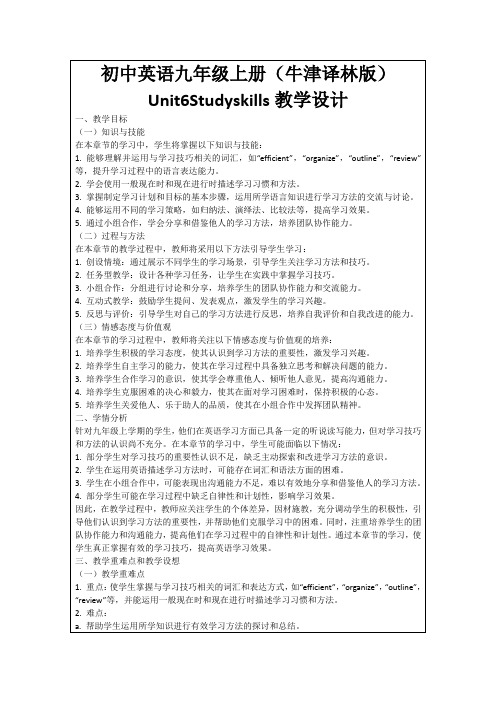
3.学生在小组合作中,可能表现出沟通能力不足,难以有效地分享和借鉴他人的学习方法。
4.部分学生可能在学习过程中缺乏自律性和计划性,影响学习效果。
因此,在教学过程中,教师应关注学生的个体差异,因材施教,充分调动学生的积极性,引导他们认识到学习方法的重要性,并帮助他们克服学习中的困难。同时,注重培养学生的团队协作能力和沟通能力,提高他们在学习过程中的自律性和计划性。通过本章节的学习,使学生真正掌握有效的学习技巧,提高英语学习效果。
b.拍摄一段视频,介绍自己的学习环境、学习习惯和常用学习方法。
3.小组作业:
a.以小组为单位,总结讨论有效的学习方法,制作成一份PPT,并在下节课上进行分享。
b.小组成员互相监督,按照本周制定的学习计划进行学习,并在小组内汇报学习进度。
4.拓展作业:
a.阅读一篇关于学习技巧的文章,并摘录其中的有用信息,与同学分享。
作业提交时间:本周五之前。
3.教学步骤:
a.学生观察图片,思考问题。
b.教师邀请学生分享自己的学习方法。
c.学生讨论各种学习方法的有效性。
(二)讲授新知
1.教学内容:介绍与学习技巧相关的词汇(efficient, organize, outline, review等)和一般现在时、现在进行时在描述学习习惯和方法中的应用。
2.设计意图:帮助学生掌握新知识,为实际运用打下基础。
初中英语九年级上册(牛津译林版)Unit6Studyskills教学设计
一、教学目标
(一)知识与技能
在本章节的学习中,学生将掌握以下知识与技能:
1.能够理解并运用与学习技巧相关的词汇,如“efficient”,“organize”,“outline”,“review”等,提升学习过程中的语言表达能力。
牛津译林版七年级下册教案:Unit6 Study skills教学设计
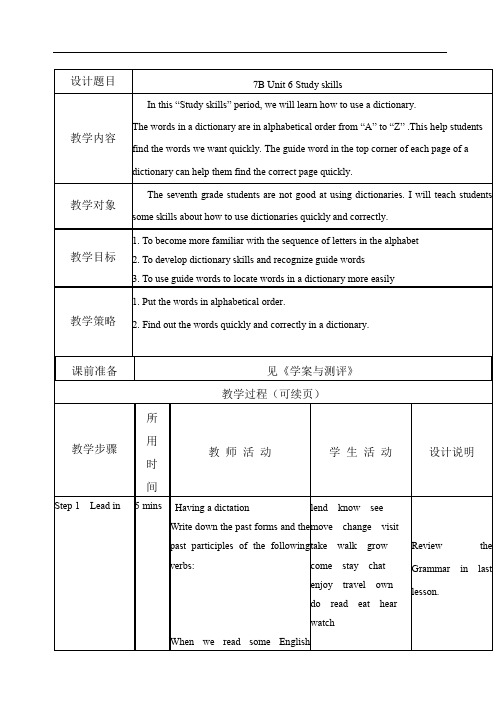
设计题目7B Unit 6 Study skills教学内容In this “Study skills ” period, we will learn how to use a dictionary.The words in a dictionary are in alphabetical order from “A ” to “Z ” .This help students find the words we want quickly. The guide word in the top corner of each page of a dictionary can help them find the correct page quickly.教学对象The seventh grade students are not good at using dictionaries. I will teach students some skills about how to use dictionaries quickly and correctly. 教学目标1. To become more familiar with the sequence of letters in the alphabet2. To develop dictionary skills and recognize guide words3. To use guide words to locate words in a dictionary more easily 教学策略1. Put the words in alphabetical order.2. Find out the words quickly and correctly in a dictionary.课前准备 见《学案与测评》教学过程(可续页)教学步骤所用 时 间教 师 活 动学 生 活 动设计说明Step 1 Lead in 5 minsHaving a dictationWrite down the past forms and the past participles of the following verbs:When we read some English lend know seemove change visit take walk grow come stay chat enjoy travel owndo read eat hear watchReviewtheGrammar in last lesson.Step 2 Presentation Step 3 Practice Step 4 Presentation Step 5 PracticeStep 6 Playing agame8 mins6 mins5 mins6 mins 15 mins books, newspapers or magazines, we will meet some new words we haven’t learned, what should we do? We can use a dictionary. The words in a dictionary areplaced in an alphabetical order from ‘A’ to ‘Z’. This helps us find the words we want quickly. Mr Wu is teaching his students about the alphabetical order. He asks them to put the following words in an alphabetical order. Finish Part A on page 20. The guide word in the top cornerof each page of a dictionary helps you find the correct page quickly.On the left are some page numbers and guide words from adictionary. Finish Part B on page20.1. Give students some codedsentences. Tell them that in orderto decode the message they must Ask students to call outthe letters of the alphabet (A-Z) in order. If two words start withthe same letter, we look at the second letter to decide the alphabetical order. If the first twoletters of two words are the same, we look at the third letter, and so on.ball‘l’ comes before ‘n’ banana ‘a’ comes before ‘k’bank…e.g. Ohyyz hr lx ezuntqhsd ennc. (Pizza is my favourite food.) Kds’r fn sn sgd bhmdlz. (Let’s go to the cinema.) Make the students know what theimportance of adictionary.Encourage the students to knowthe rule.Make studentsunderstand the useof the guide word.Step 7 Homework replace each letter with the letterthat comes before it in thealphabet.2. Give students some codedsentences. Tell them that in orderto decode the message, they mustreplace each letter with the letterthat comes after it in the alphabet.3.Give the students moreexercises to practice.1.Try to do more consolidationwork about arranging words in analphabetical order.2.Finish the exercises in theworkbook.e.g. Upebz jt Uivstebz.(Today is Thursday.) Jmjlf dipdpmbuf. ( I likechocolate.) Xf mjwf joCfjkjoh. (We live inBeijing.) Uif tvo sjtft jouif fbtu. (The sun risesin the east.)Snlnqqnv hr Ixahqsgczx. (Tomorrow ismy birthday.) Zix gzritrs addm sn sgdkhaqzqx. (Amy has justbeen to the library.)Line themselves up inan alphabetical order byname.Finish the homework intime.Do some exerciseto make students bemore familiar withit.Consolidate theknowledge theyhave learnt.。
初中英语八年级下册(牛津译林版)Unit6Studyskills教学设计

4.小组合作,讨论并整理出本节课所学词汇和短语的用法,以PPT或手抄报的形式展示,培养学生的团队合作能力和表达能力。
-要求:每组选择一名负责人,分工合作,确保内容准确无误,下节课进行展示。
5.观察并记录一周内的学习习惯,思考如何改进,以提高学习效率。将观察结果以日记或周记的形式撰写,培养学生的自我反思能力。
-小组内分享学习心得,总结出有效的学习方法和策略。
2.教学支持:
-教师巡回指导,关注每个小组的讨论情况,给予必要的帮助和指导。
-鼓励学生用目标语言进行讨论,提高语言运用能力。
(四)课堂练习
1.教学活动:
-设计不同类型的练习题,如填空、选择、改错等,涵盖本节课的核心知识点。
-学生独立完成练习题,教师给予个别辅导。
2.教学支持:
-引导学生运用思维导图等工具,将所学知识进行整合,形成知识体系。
-鼓励学生课后运用所学方法进行学习,养成良好的学习习惯。
五、作业布置
为了巩固本章节所学知识,培养学生的自主学习能力,特布置以下作业:
1.完成本节课的练习册相关习题,包括词汇填空、语法选择、翻译等,以提高学生对目标语言的理解和运用能力。
初中英语八年级下册(牛津译林版)Unit6Studyskills教学设计
一、教学目标
(一)知识与技能
1.掌握本章节的核心词汇和短语,如:effective, efficient, schedule, prioritize, review, summary等,并能熟练运用到日常生活和学习场景中。
2.学会使用一般现在时和一般过去时描述学习习惯和方法,并能运用目标句型进行讨论和交流,如:“I usually do my homework in the evening.”、“He reviews his lessons every weekend.”等。
牛津译林版英语九年级上Unit6 Study skills教学设计(英语教案)
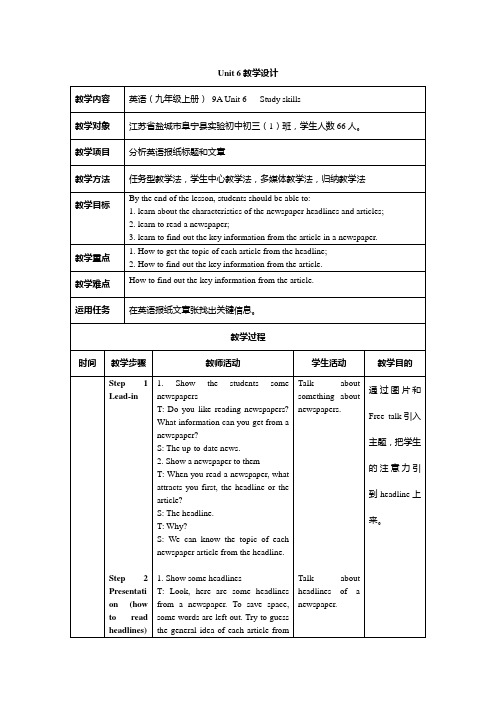
T: Can you ask questions about it?
S: …
T: Read the article quickly and try to find out the answers.
3. Write a headline according to the article.
h. Use the context to guess the meaning of any words you don’t know.
S: We should choose a, b, d, f and h.
2. Choose a headline, ask questions about it and answer them.
1. Tips on reading a newspaper
T: Many students often read English newspaper articles in a wrong way. They pay more attention to looking up the words, which makes them read slowly.
S: A Cat show was held in Shanghai.
(3) Xi’an travel tips
S: Here are some Xi’an travel tips.
2. Compare the headlines with the sentences and find out the rules.
2.
T: Read the article quickly. Try to find out the answers to these questions.
【译林版七年级英语下册教案】Unit 6 Study skills
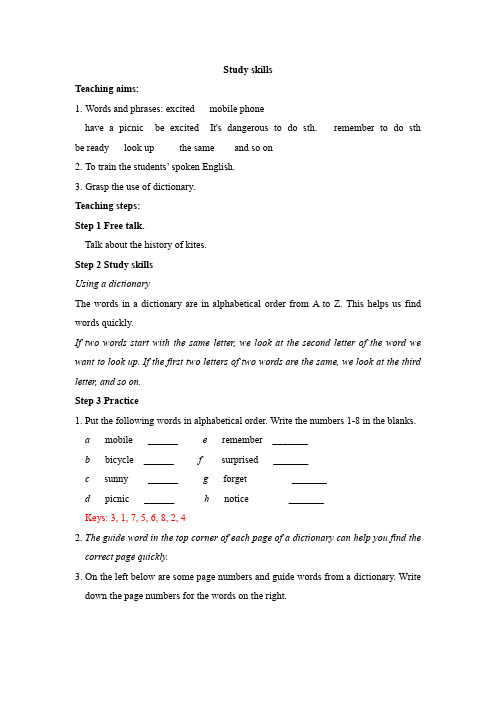
Study skillsTeaching aims:1.Words and phrases: excited mobile phonehave a picnic be excited It's dangerous to do sth. remember to do sth be ready look up the same and so on2.To train the students’ spoken English.3.Grasp the use of dictionary.Teaching steps:Step 1 Free talk.Talk about the history of kites.Step 2 Study skillsUsing a dictionaryThe words in a dictionary are in alphabetical order from A to Z. This helps us find words quickly.If two words start with the same letter, we look at the second letter of the word we want to look up. If the first two letters of two words are the same, we look at the third letter, and so on.Step 3 Practice1. Put the following words in alphabetical order. Write the numbers 1-8 in the blanks.a mobile ______ e remember _______b bicycle ______ f surprised _______c sunny ______ g forget _______d picnic ______ h notice _______Keys: 3, 1, 7, 5, 6, 8, 2, 42. The guide word in the top corner of each page of a dictionary can help you find the correct page quickly.3. On the left below are some page numbers and guide words from a dictionary. Write down the page numbers for the words on the right.Step 4 Language points1). look up 查找在字典里查找这个单词。
- 1、下载文档前请自行甄别文档内容的完整性,平台不提供额外的编辑、内容补充、找答案等附加服务。
- 2、"仅部分预览"的文档,不可在线预览部分如存在完整性等问题,可反馈申请退款(可完整预览的文档不适用该条件!)。
- 3、如文档侵犯您的权益,请联系客服反馈,我们会尽快为您处理(人工客服工作时间:9:00-18:30)。
(UNIT 3,Welcome to Sunshine Town)Teaching plans for Period 6:Study skills一、教学目标:1. 什么是句子重音?2.句子重音的功能3. 哪些词在句子中需重读3、基本了解音节的定义和划分原则;难点:句子重音的读法。
一、预习导学:一、什么是句子重音?我们在朗读英语或用英语交谈时,并不是句子中的每个词都读得一样响亮。
一样清楚,而是有些词读得或说得又轻又快,而且较为含糊,有些词则读得或说得又重又慢,而且较为清晰。
那些读得或说得响亮而清晰的词就是句子重音所在。
二、句子重音的功能1.体现句子的节奏感和韵律感。
2.突出重点,使听者更容易理解。
三、哪些词在句子中需重读?1.一般来说,在句子中需重读的词都是实词,比如,名词、动词、形容词、副词、数词、代词等。
不重读的多为虚词,比如,冠词、连词、介词、感叹词等。
例如:The streets are wide and clean. (这句话中的streets是名词,wide和clean是形容词,它们都要重读;the, are, and不重读。
)I am so glad to see you again. (这句话中的so, glad, see, again要重读,而I, am, to, you不重读。
)2.有时候虚词也要重读,以下几点需注意:1)强调或突出某个虚词或be动词时,应将其重读。
例如:We saw him playing by the river.(这句话中的we和him一般不重读,但为了表示强调也可以重读。
比如,如果we重读,则强调是“我们”而不是别人看见。
)2)介词在句首时往往要重读。
例如:On my way to school, my bike was broken. (这句话中的on在句首应重读。
)3)be动词及助动词和not结合时要重读。
例如:I]m sorry I can]t do that.(这句话中的can]t要重读。
)Didn’t I tell you yesterday? (这句话中的didn’t要重读。
)4)句子末尾的be动词和助动词一般要重读。
例如:-Are you a student? -Yes, I am. (这里的am要重读。
)注意:上文刚出现过的并且重读的单词,第二次提到时一般不再重读。
如:—How many boys are there in the room?—There are twenty boys in it. (问句中的boys要重读,但答语中的boys 不重读。
)预习自测:1. Listen to the following conversation. Pay attention to the stressed words. Millie: Where are you going, Sandy?Sandy: I’m going to the bookshop.Millie: What are you going to buy?Sandy: My pen is broken. I want to buy a new one.Millie: I need some exercise books. Shall I go with you?Sandy: Sure.2. Read the sentences below. Stress the different words according to the meanings you want to express.1 I want to buy a CD at the bookshop.a I am talking about what I want to do, not what I do not want to do.b I am talking about a bookshop, not another shop.c I am talking about a CD, not something else.2 Daniel sometimes watches TV on Sund ay morning.a I am talking about watching TV, not another activity.b I am talking about Daniel, not another student in the class.c I am talking about Sunday morning, not another morning.课堂教学活动:Step1:Greetings and revision.Step2:Read and learnStep3: Discussion.Step4: Read and write.Step5: Do more exercises.后记(UNIT3,Welcome to Sunshine Town)Teaching plans for Period7:Task一、教学目标:1、熟练掌握一下字词句:nearby, wonderful, sunny, type. youth centre, ride a bicycle, play ball games,I’m going to show you around my hometown.It takes about twenty minutes to get to the nearest town.I’m going into town on my bicycle.I think it is a wonderful place to live (in).2、学会用所学知识描绘自己的家乡;3、掌握本课重要的描绘家乡的短语和句子。
4、学习如何描述自己的家乡。
5、难点:学会灵活运用所学知识来描绘自己的家乡。
二、预习导学:1、I’m going to show you around my hometown.show sb around: 带某人四处看看Please come to my house and I’ll show you around.翻译:那位工人带孩子们在工厂里到处参观。
That worker ____________________________________________.2、Here is my house.这是一个倒装句。
具有强调地点的效果。
来看看下面的句子:Where is my bag?—Here it is! Under the desk.Can I borrow your pen?—Sure. Here you are.Here comes the bus.3、It takes twenty minutes to get to the nearest town.It takes +一段时间+to do. 做某事要花费…时间take 表示“花费”讲时只能用于时间,因此要注意与spend 的区别。
此句的同义句为:I spend twenty minutes getting to the nearest town.另外:get to 是“到达”的意思,有同样意思的词还有reach 和 arrive.但它们的用法可不同,试看下面的题目,然后自己总结一下:用arrive get reach 填空:Simon _________ in Beijing two years ago.When I _____________ home, I couldn’t find my father.Hurry up, so you can ______ to the airport on time.When I _______ at the bus stop, my friend was w aiting for me there.4、There are lots of things to do there and I am always busy.things to do: 要做的事。
to do 在这里理解为不定式作定语。
类似的短语有:homework to do work to finishsomething to eat something to drinka good place to go a wonderful place to live5、I like going into town on my bicycle. 我喜欢骑车进城。
on one’s bicycle == on one’s bike==by bike6、I think it is a wonderful place to live. 我认为这是个居住的好地方。
居住在某个地方通常说成to live in a place, 因此上面这个句子也可以说成;I think it is a wonderful place to live in.7、I hope you can come and visit soon. 我希望你很快就能过来参观。
注意hope的用法: hope to do 希望做某事hope (that)+从句希望…….不能说: hope sb to do sth.I hope _______ with his wife tonight.(A)him come to my birthday party(B)he to come to my birthday party(C)to him to come to my birthday party(D)he can come to my birthday party预习自测:1、词汇专项练习:1)It’s ________(晴朗的) today. Let’s go hiking.2)I often go shopping in the supermarket __________(附近的)。
3)The football match in this afternoon is really w_________ (精彩的). You mustn’t miss it.4)A bike can be also called a b__________.5)Can you r_______ a horse? It’s a little dangerous.2、翻译下列词组:带某人参观________________ 骑自行车____________________在周末__________________ 种蔬菜_____________________到达最近的城镇______________________________________告诉你关于我家乡的情况_______________________________________ 三、课堂教学活动:Step1: Daily report.Step2: DiscussionStep3: Listen, read and sayStep4: Read and learnStep5: Read and write四、后记:。
